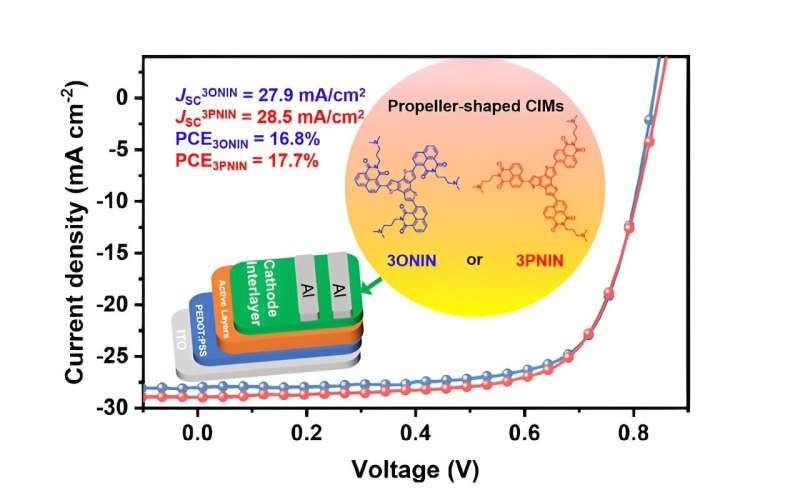Due to the difference in planarity of the two isomers 3ONIN and 3PNIN, 3PNIN based OSCs show a higher power conversion efficiency relative to 3ONIN based devices. Credit: Minghua Huang, Ocean University of China
Imagine technology as a race car speeding down a track—it can only go as fast as its engine allows. But just when it seemed like organic solar cells hit a roadblock, along comes 3PNIN, a game-changing molecule shaped like a propeller, ready to turbocharge their progress and break through barriers.
Organic solar cells (OSCs) represent the pinnacle of renewable energy, yet certain components have fallen significantly behind the trajectory of ongoing development. Particularly, cathode interfacial materials (CIMs) have failed to sustain the momentum necessary to match the continuous enhancement of OSCs.
CIMs play a critical role in facilitating current conduction from the metal to the semiconductor and vice versa; hence, if they fall short in electron-transport performance, the power conversion efficiency (PCE) of OSCs is compromised. In response to this challenge, researchers delved into investigating how molecular structure impacts the overall performance of both the cell and the interfacing materials.
Two propeller-shaped compounds exemplify the significant influence that molecular configuration can exert on enhancing the functionality of CIMs and, consequently, the photovoltaic performance of OSCs.
Researchers published their results in Nano Research.
The study reported two isomers, 3PNIN and 3ONIN, which are molecules sharing the same formula but possessing distinct arrangements of end-capped groups. These varied group arrangements enable different intermolecular interactions to take place within one isomer that may not be achievable with the other.
"In the vast realm of renewable energy, OSCs have ascended to prominence, characterized by their ethereal architecture, semi-transparency, cost-effective production, and scalable printed assembly, heralding a new era in powering flexible wearable technologies," remarked Prof. Minghua Huang, an author of the study.
The significance of this technology in a world where sustainable energy sources have gained considerable traction (and necessity) cannot be overstated. Upon testing the propeller-shaped isomers presented in this research, results revealed that the two compounds can exert vastly different effects based on their configuration, with one variant outperforming the other in enhancing the functionality of CIMs.
3PNIN exhibits a more planar molecular structure compared to its counterpart, 3ONIN. This structural disparity enables the end-capped groups in 3PNIN to lie flatter relative to 3ONIN, thereby demonstrating significant enhancements in functionality, such as electron mobility and conductivity. "As a result, 3PNIN and 3ONIN-treated OSC devices yield PCEs of 17.73% and 16.82%, respectively," said Huang.
3PNIN displays significant promise in fabricating a thermally stable device while also enhancing PCE of OSCs, in addition to the benefits of improved mobility and conductivity compared to the prevailing technology widely utilized for CIMs. Further refinement of OSC devices treated with the 3PNIN isomer holds the potential to advance the accessibility and efficiency rates of this energy source.
Enhancements in OSCs can exert a widespread impact on the renewable energy landscape and may extend to other realms of technology reliant on organic electronics.
More information: Hao Liu et al, Propeller-shaped NI isomers of cathode interfacial material for efficient organic solar cells, Nano Research (2024). DOI: 10.1007/s12274-024-6482-z
Provided by Tsinghua University Press
























